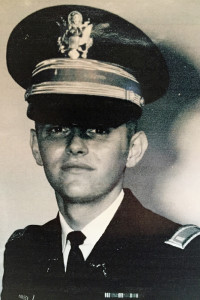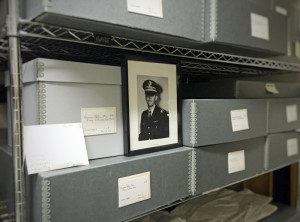True Tales from Canton’s Past: Grey Boxes
By George T. ComeauAs soon as you open the door, cool air sweeps across your face and you quickly enter the small room. This is a special place, and as your eyes adjust to the dim light, large stainless steel racks come into focus. Dozens of grey boxes, all neatly hand labeled, line the shelves. And inside many of the boxes are memories of our war dead. The boys and girls who served bravely and, in many cases died, are remembered here.
This is the Wally and Marie Gibbs Textile Room at the Canton Historical Society, and it is in many ways as sacred as any monument or grave that is dedicated to war heroes. For it is here in this special place that uniforms and regalia connected to over 150 years of conflict are protected and preserved. The textile fund that has supported this work is just about depleted, and yet work is far from finished. After the noted town historian Edward Lynch passed away, his wife, Tara, made possible a generous donation that would begin the work of the historical society’s textile committee. And that work has been tireless.
The local historical society had been collecting military artifacts almost since its founding in the late 1800s. After the Civil War, many of the soldiers returned home and formed the Grand Army of the Republic (GAR), which served as a veterans organization. The GAR headquarters for many years was located in upper Memorial Hall, the very building that was built to commemorate the fallen boys from Canton who died on southern battlefields.
The GAR rooms were packed with uniforms, books, photographs, weapons, and all things related to the Great War. At some point long after the last veteran had passed away, the rooms were unceremoniously swept and the relics were carted off to the town dump and disposed of. What little was deemed worthy of saving was given to the society and they displayed some items while storing the rest. It was a far different time, and the appreciation and archival methods for preservation only became paramount within the last 20 years or so.
As for the military uniforms, they largely encompass those from the Sons of the GAR and from the subsequent wars of the 20th century. Until the past decade, the clothing had been stored in the basement in moldering trunks and boxes. It was Wally and Marie Gibbs who took a special interest in the textiles and began to discover some amazing and worthy items that deserved special protection and preservation. We all know about the quilts and the postcolonial clothing. But it is the sacred duty of protecting the uniforms that raise the most responsibility and need for care.
When the family of Marine Brigadier General Willis Neal visited a few weeks ago, they were able to touch his dress uniform and connect to a valiant war record that still speaks volumes about the man and his place in America. Inside an acid-free box is one of only two Japanese sniper coats to have survived the war — and Neal had made sure that the one he had collected was given to the Canton Historical Society. The only other known example is in the Smithsonian Institution. The fact that special care must be taken to preserve this item must be noted, as it is a window into a very dark time in our country’s history.
Each gray acid-free box contains enormous amounts of significance — none perhaps more so than box 13. This box is part of a small series of boxes, all containing the uniform of Lieutenant Peter Mykal Hansen. Many of the children in Canton have and will attend the Hansen School. And long after the school is replaced, the historical society will still preserve his uniform. Inside box 13 is a raven black hat, trimmed in gold and made by Morry Luxenberg Military Outfitters. This was the same company that had outfitted General Patton and thousands upon thousands of officers and enlisted men alike. The hat has a wide leather brim, trimmed in cork on the inside, and two gold American eagle buttons fasten the metallic braid. Atop the front of the hat is the Great Seal of the United States.
When you touch this hat, you are indeed connecting to one of Canton’s bravest men, and someone who should never be forgotten. Hansen was the first of Canton’s sons to fall in Vietnam and the first to have a public building named for him. In this day of naming fields and buildings for departed friends of Canton, the true heroes are sometimes still forgotten. Fortunately, this is not the case with Hansen. So great was his loss that the town named the new school for him less than two years after his death.

1st Lt. Peter Hansen was only 22 when he was killed in Vietnam. (Courtesy of the Canton Historical Society)
Born in Brockton in 1945, Hansen grew up in Canton at 39 Van Buren Street. Graduating from Canton High School in 1963, he showed a particular aptitude for mathematics. After graduation, Hansen worked with a local cabinetmaker and had a short stint at Plymouth Rubber. By 1965, as the conflict began heating up in Southeast Asia, Hansen enlisted in the United States Army for a three-year term. He would die within two years and two months and Canton would mourn the loss of this amazing young man.
Hansen was very smart, and although he did not attend college he showed a keen aptitude for mechanics and possessed unique intelligence. Basic training was at Fort Dix and he was recruited for Officers Candidate School soon thereafter. Rising quickly, he was skilled in advanced warfare techniques and by 1966 was an acting drill sergeant. In October 1966, Hansen was commissioned as a second lieutenant and volunteered to go to Vietnam in August 1967. Stationed as a liaison officer to headquarters, 2nd Battalion, 34th Armor of the 25th Division, Hansen was responsible for the defense perimeter in the war zone around the Tay Ninh base camp.
Three and a half months after his arrival at the battalion, Peter Hansen lost his life. On Wednesday, November 29, 1967, the 22 year old rode in an Army jeep down a road in the Binh Doung deep inside the Iron Triangle. Accounts of his death differ, but in a telegram to his mother it was stated that the vehicle he was riding in hit an enemy land mine. By mid December his body was returned to Canton, and on a day filled with rain, sleet and snow — apropos for the sadness that blanketed the town — our valiant young man was laid to rest at St. Mary’s Cemetery. The American flag, damp with snow, was folded and handed to Peter’s brother, Sergeant Stanley Hansen. Gloved hands passed the flag to Stanley as he in turn approached his mother. With sadness and deep sorrow, the mother and child embraced as the honor guard, buglers, bearers, and a full contingent of officers and soldiers from Fort Devens escorted Marian from her son’s grave.
Memories fade, and time erodes the conscience. Yet by simply opening that gray box, the hat tells a story that transcends time. We must weep, we must honor, and we must preserve the memory of all the soldiers from Canton. The hope is that we no longer add boxes to the shelves, and instead open them to allow ourselves the glory of the men and women who died for the United States of America.
The Canton Historical Society is soliciting donations to the military textile fund. Please consider a tax-deductible donation in the name of a loved one or veteran. Send donations to Canton Historical Society, 1400 Washington St., Canton, MA 02021.
Short URL: https://www.thecantoncitizen.com/?p=33786











